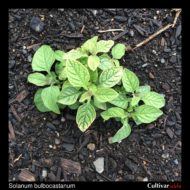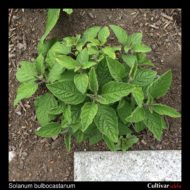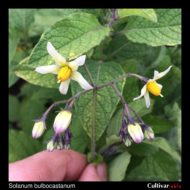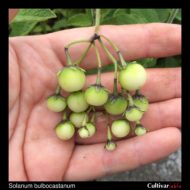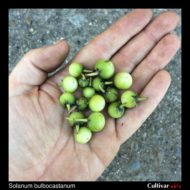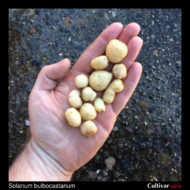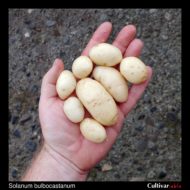Solanum bulbocastanum
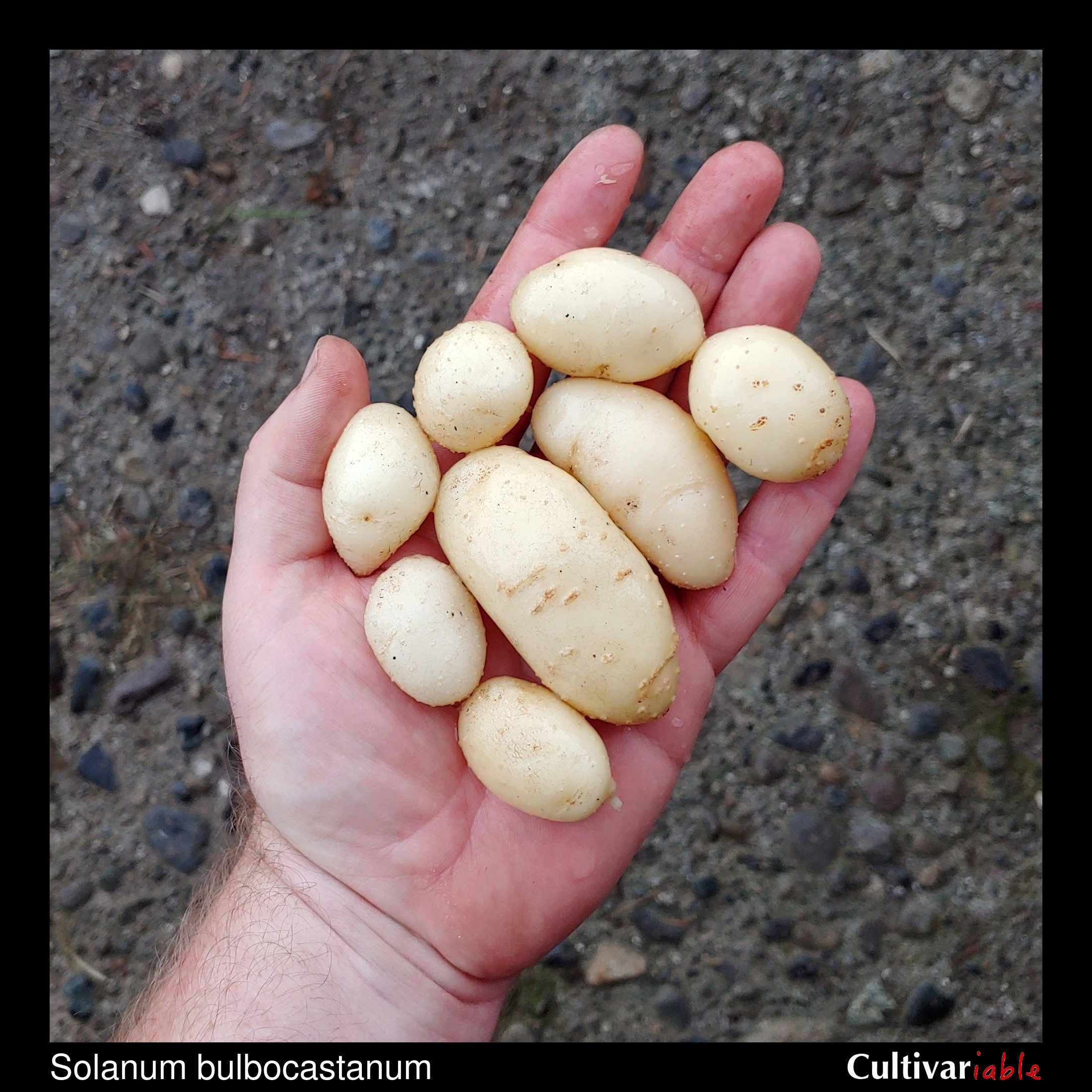
| Common Names | |
| Code | blb |
| Synonyms | S. symphisicaulis |
| Clade | 2 |
| Series | Bulbocastana |
| Ploidy | Diploid (2x), Triploid (3x) |
| EBN | 1 |
| Tuberization Photoperiod | Short Day |
| Self-compatibility | No |
| Nuclear Genome | B |
| Cytoplasmic Genome | W |
| Citation | Dunal: J. L. M. Poiret, Encycl. suppl. 3:749. 1814 |
Description
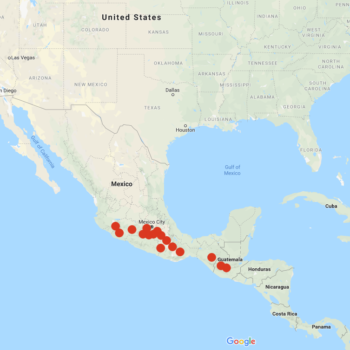
Solanum bulbocastanum is a widespread species ranging from northern Mexico south to Guatemala and Honduras, growing under both dryland and woodland conditions. Plants reach about three feet tall. Simple leaves. Flowers white to light yellow. Round berries.
The specific epithet, bulbocastanum, means something like “chestnut tuber”. It isn’t clear what this refers to – probably not the flavor of the tubers, which are generally bitter, so perhaps the size. It is formed from the Latin words “bulbus,” for “bulb,” and “castanea,” for “chestnut.” While there is no completely standardized pronunciation for scientific names, the most common way to pronounce this species is probably so-LAY-num bul-boh-kah-STAY-num.
Subramanian (2017) found that different accessions of this species had both unusually low and unusually high calcium content. They were also unusually high in dry matter content.
Resistances
Bethke (2017) scored wild potato species as a composite of seven resistance studies and S. bulbocastanum ranked in first place by a significant margin.
This species can survive frosts down to 27 degrees F (-3 C) (Li 1977). Vega (1995) found that this species is less frost tolerant than domesticated potato. It has the greatest resistance to potato virus Y among wild potatoes (Chung 2011).
Three major late blight resistance genes have been identified in this species: Rpi-blb1/RB, Rpi-blb2, and Rpi-blb3.
| Condition | Type | Level of Resistance | Source |
|---|---|---|---|
| Aphids | Invertebrate | Resistant | Machida-Hirano 2015 |
| Aphids | Invertebrate | Not resistant | Alvarez 2006 |
| Ralstonia solanacearum (Bacterial Wilt) | Bacterium | Somewhat resistant | Machida-Hirano 2015 |
| Meloidogyne chitwoodi (Columbia Root Knot Nematode) | Invertebrate | Somewhat resistant | Brown 1989, Graebner 2018b |
| Drought | Abiotic | Somewhat resistant | Machida-Hirano 2015 |
| Alternaria solani (Early Blight) | Fungus | Resistant | Prasad 1980 |
| Alternaria solani (Early Blight) | Fungus | Somewhat resistant | Jansky 2008 |
| Heat | Abiotic | Somewhat resistant | Machida-Hirano 2015 |
| Phytophthora infestans (Late Blight) | Fungus | Resistant | Machida-Hirano 2015 |
| Phytophthora infestans (Late Blight) | Fungus | Resistant | Bachmann-Pfabe 2019 |
| Globodera rostochiensis (Potato Cyst/Golden Nematode) | Invertebrate | Somewhat resistant | Machida-Hirano 2015 |
| Globodera pallida (Pale Cyst Nematode) | Invertebrate | Not resistant | Bachmann-Pfabe 2019 |
| Potato Virus Y (PVY) | Virus | Somewhat resistant | Cai 2011 |
| Meloidogyne spp. (Root Knot Nematode) | Invertebrate | Somewhat resistant | Machida-Hirano 2015 |
| Pectobacterium carotovorum (Blackleg) | Bacterium | Somewhat resistant | Chung 2011, Machida-Hirano 2015 |
| Synchytrium endobioticum (Wart) | Fungus | Somewhat resistant | Machida-Hirano 2015 |
Glykoalkaloid Content
There is very little information available about glycoalkaloids in this species. Gregory (1981) tested foliage and found very low glycoalkaloid content and no detectable solanine or chaconine in the single accession that they tested. Foliage normally has much higher glycoalkaloid content than tubers, so this suggests that the tubers are probably low as well, but that is just a supposition. I have tasted tubers from several accessions and found a range from non-bitter to immediately and punishingly bitter.
Images
Cultivation
I have found seeds of this species easy to germinate using the standard conditions for S. tuberosum.
Towill (1983) found that seeds of this species stored at 1 to 3 degrees C germinated at 76% after 21 years.
Bamberg (2018) found that alternating temperatures decreased germination in this species.
Breeding
Crosses with S. tuberosum
| Female | Male | Berry Set |
Seed Set | Germ | Ploidy | Source |
|---|---|---|---|---|---|---|
| S. bulbocastanum | S. tuberosum 4x | None | None | Jackson (1999) | ||
| S. tuberosum 4x | S.bulbocastanum | None | None | Jackson (1999) | ||
Crosses with other species
Watanabe (1991) found that 5.9% of varieties of this species produced 2n pollen and Jackson (1999) found 2-4%, which would be effectively tetraploid and 2EBN. S. bulbocastanum x S. cardiophyllum hybrids produced 2n pollen in 9.1% of plants.
Matsubayashi (1977) examined chromosome pairing in hybrids and determined that crosses between S. bulbocastanum and S. jamesii or S. x sambucinum were successful but with irregular chromosome pairing and poor pollen fertility.
| Female | Male | Berry Set |
Seed Set | Germ | Ploidy | Source |
|---|---|---|---|---|---|---|
| S. jamesii | S. bulbocastanum | Yes | Yes | 2x | Matsubayashi 1977 | |
| S. x sambucinum | S. bulbocastanum | Yes | Yes | 2x | Matsubayashi 1977 |
References
Solanum bulbocastanum at Solanaceae Source

